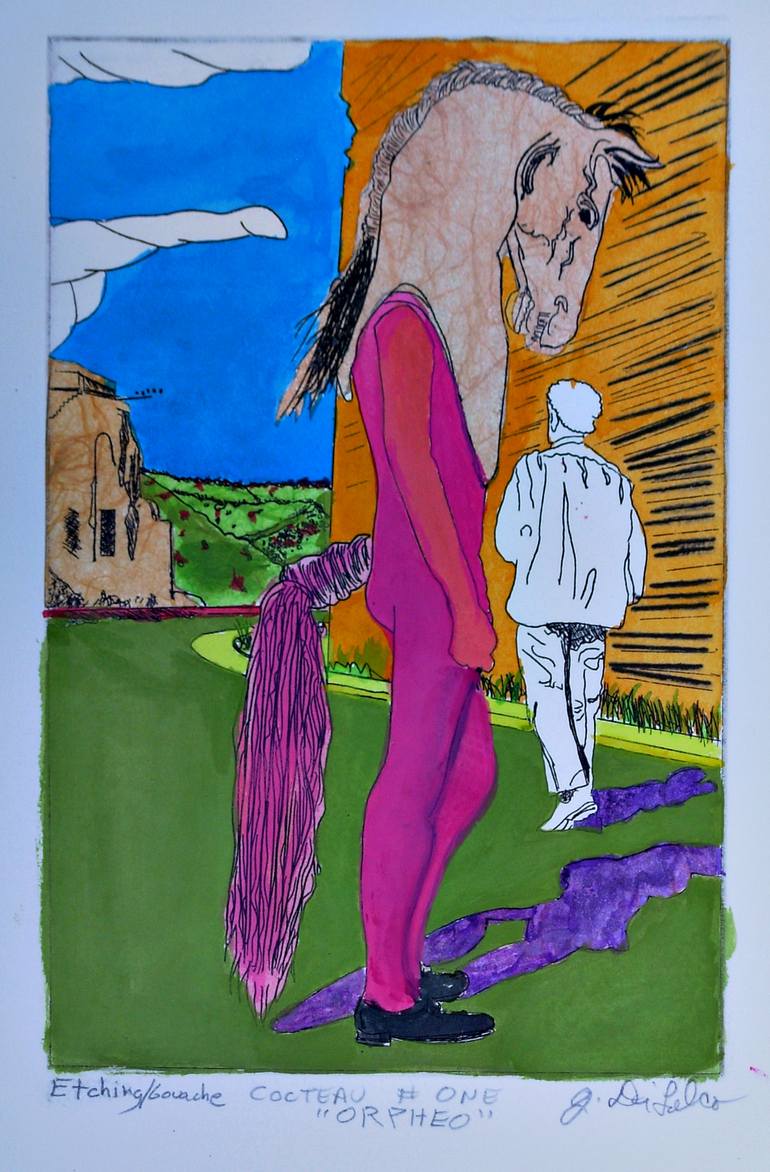


VIEW IN MY ROOM
COCTEAU # ONE: ORPHEO Painting
United States
Painting, Gouache on Paper
Size: 12 W x 16 H x 1 D in
Ships in a Box
Artist Recognition

Artist featured in a collection
About The Artwork
NOTE: THIS ETCHING IS SHIPPED TO THE COLLECTOR WITH AN ARCHIVAL MAT AND FRAME THE QUOTED PRICE INCLUDES ALL REGULAR DOMESTIC (USA) SHIPMENT COSTS TO THE BUYER (about $45.00). This work, which incorporates the genres of printmaking and painting, is a cinematic study from French filmmaking. I combined an artist proof of one of my etchings and enhanced it printed with gouache, watercolour, and Japanese gold Sumi ink. The etching was created with the studio techniques of intaglio, aquatint, Chine colle, and drypoint; I used a Parisian etching ink—Charbonnel brand—and RivesBFK white paper from France. In the Chine colle process, a Thai mulberry bark paper was used with methyl cellulose. I used a Parisian etching ink—Charbonnel brand—and RivesBFK white paper from France. The image size is nine inches high by six inches wide (22.5 cm x 15 cm); and, the print size is fifteen inches high by eleven inches wide (31.8 cm x 37.5 cm). I hand printed and published the editions at The Center for Works on Paper in Philadelphia, Pennsylvania, within the Fleisher Art School’s Open Studio In Printmaking. NARRATION—The scene in this painted etching was adapted from a publicity photo from Jean Cocteau’s final film entitled, “Le Testament d'Orphée”. The original title for Cocteau’s 1960 film was, “Le Testament d'Orphée, Ou Ne Me Demandez Pas Pourquoi”. Cocteau both directed and starred in this film, which is the last movie in his ORPHIC TRILOGY. The first film in the trilogy was created in 1930 and titled, “THE BLOOD OF A POET; The second film, created twenty years later in 1950, was titled, ORPHÉE. The cast for the 1960 film includes: Charles Aznavour; Lucia Bosé; Maria Casarès; Nicole Courcel; Luis Miguel Dominguín; Daniel Gélin; Jean-Pierre Léaud; Serge Lifar; Jean Marais; François Périer; and, Françoise Sagan. Cameo appearances were also made by Pablo Picasso and Yul Brynner. The work is shot using black and white film, yet has a few seconds of color edited into it. Cocteaus’ “Le testament d'Orphée” involves the metaphysical elements of time travel, dream consciousness, and the nexus between death and rebirth. Other themes include: Gods and Goddesses: the law: and visionary insights into life by every poet.
Original Created:2020
Subjects:Cinema
Materials:PaperSoft (Yarn, Cotton, Fabric)Other
Mediums:GouacheWatercolorInkEtchingPaper
Details & Dimensions
Painting:Gouache on Paper
Original:One-of-a-kind Artwork
Size:12 W x 16 H x 1 D in
Frame:Other
Ready to Hang:Not applicable
Packaging:Ships in a Box
Shipping & Returns
Delivery Time:Typically 5-7 business days for domestic shipments, 10-14 business days for international shipments.
Handling:Ships in a box. Artists are responsible for packaging and adhering to Saatchi Art’s packaging guidelines.
Ships From:United States.
Have additional questions?
Please visit our help section or contact us.
United States
Imagery and storyline—both vital components of my creative process—enable me to create a form of visual poetry. Consequently, photography is intricate to my artistic strategy, especially with regard to my etchings. In view of this, many of my printed images—accomplished via the studio techniques of intaglio, aquatint, drypoint, and Chine collè—originate from my own photographs, as well as ones I uncover during research into the archives of academia, historical societies, and museums. Upon locating a scene that fascinates me, I first sketch a few original drawings of the likeness, and next transfer that drawing onto my prepared zinc etching plate. NOTE: In my etchings that incorporate the Chine collè process, I use mulberry bark paper from Thailand, which is infused with Japanese kozo threads. The paper is also treated with methylcellulose. I endeavor to establish links between the metaphysical and physical worlds . . . between the realms of dream and reality . . . and between the natural and the fabricated. In a sense, I believe that art unveils everything that we mask behind our assumptions and biases . . . or rather, those realms we neglect—or refuse—to perceive. My label for our failure to examine these areas is, “The Phenomenology of Non-Connectedness", which I blame on today’s communicational tools such as Social Media, the Internet, texting on smart phones, and “tweeting”. MY ETCHING TECHNIQUE I work on metal etching plates treated with both hard and soft grounds. These grounds consist of mineral spirits, beeswax, oil of spike lavender, and other natural substances. After these grounds dry, I draw images with needles and other tools onto the plate. Next, the exposed areas are “etched into” the zinc or copper plate in a bath of Nitric Acid and spring water. An artist’s proof in then printed after the plate is cleaned; Moreover, two to seven additional plate workings, acid baths, and proof printings occur before my desired effect is obtained. When satisfied with my end result, I apply oil based etching ink onto the clean plate and then remove the excess ink with several wipes. Next, I align my etching plate onto the printing press bed and cover it with papers and press blankets. Finally, the plate goes through the press to obtain my print. This process is repeated until all editions are created. I usually create three to five editions of five or six etchings for each one of my plates.
Artist Recognition

Artist featured by Saatchi Art in a collection
Thousands Of Five-Star Reviews
We deliver world-class customer service to all of our art buyers.
Global Selection
Explore an unparalleled artwork selection by artists from around the world.
Satisfaction Guaranteed
Our 14-day satisfaction guarantee allows you to buy with confidence.
Support An Artist With Every Purchase
We pay our artists more on every sale than other galleries.
Need More Help?